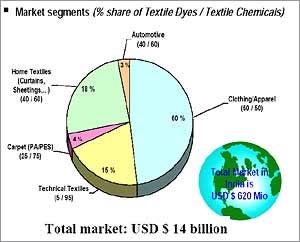Textile dyes belong to Bronze Age. If we compare this to the
21st-century, these constitute an important segment of the whole business of
specialty chemicals. Dyes that are used by the textile industry are now
mostly synthetic. They are mostly derived from two sources namely, coal tar
and petroleum-based intermediates. These dyes are marketed as powders,
granules, pastes or liquid dispersions. The concentrations of active
ingredients typically ranges from 20 to 80 percent. These are now
characterised as new dyes and are regularly developed for meeting the
demands of new technology, new kinds of fabrics, detergents, advances in
dyeing machineriest, along with overcoming the serious environmental
concerns posed by some existing dyes. Another important factor is the fact
that almost all the products are subjected to seasonal demand and variation.
Industrial textiles Dyes must rise up to meet all these new and specific
technical requirements.
With the fast changing of the product profile of the textile industry, from
high-cost cotton textiles to the durable and versatile synthetic fibres, the
pattern of consumption of these dyes is also going through rapid changes.
Now a days, Polyesters account for a major part of dye consumption.
Accordingly, disperse dyes, that is used in Polyesters, are also projected
to grow at a faster rate.
Yes! I am Interested
Classification of all the commercial textile dyes by
their generic name and chemical constitution has been done by the Color
Index (C.I.), a journal published by the Society of Dyers and Colorists
(United Kingdom) in association with the American Association of Textile
Chemists and Colorists (AATC)..
However, if we take general dye chemistry as one of the basis for
classification, textile dyestuffs can be grouped into the following
categories for an easier understanding
- Acid Dyes
- Azoic Dyes
- Basic Dyes
- Direct Dyes
- Disperse Dyes
- Reactive Dyes
- Sulphur Dyes
- Oxidation Dyes
- Mordant Dyes (Chrome Dyes)
- Optical / Fluorescent Brightener
- Solvent Dyes
- Vat Dyes
For convenience all the above dyes can be clubbed together into three
categories namely:
- Dyes for Cellulose Fibers
- Dyes for Protein Fibers
- Dyes for Synthetic Fibers
Percentage of unfixed dye for various dye types and applications
All the dyes are not fixed to the fiber during the process of dyeing. The
following Table gives the percentage of unfixed dyes for different textiles.
The reactive dye that is used for cotton shows the poorest rate of fixation.
As half of the textile-fiber market is cotton, the problems of colored
effluents stems from dyeing cotton with reactive dyes
| Fibre |
Dye Type |
Unfixed dye % |
| Wool and Nylon |
Acid dyes/ reactive dyes for wool |
7-20 |
|
Pre-metallised dyes |
2-7 |
| Cotton and viscose |
Azoic dyes |
5-10 |
|
Reactive dyes |
20-50 |
|
Direct dyes |
5-20 |
|
Pigment |
1 |
|
Vat dyes |
5-20 |
|
Sulphur Dyes |
30-40 |
| Polyester |
Disperse |
8-20 |
| Acrylic |
Modified basic |
2-3 |

![]() Profile
Profile ![]() Product Range
Product Range![]() Industries
Industries![]() Infrastructure
Infrastructure![]() Our Quality
Our Quality![]() Custom Manufacturing
Custom Manufacturing![]() Network
Network![]() Contact Us
Contact Us![]() Send Enquiry
Send Enquiry


![]()
 A
fair impression of the importance of textile dyes can be understood from
looking at the market segments, which is illustrated below:
A
fair impression of the importance of textile dyes can be understood from
looking at the market segments, which is illustrated below:![]() Profile
Profile
![]() Product
Range
Product
Range![]() Industries
Industries![]() Infrastructure
Infrastructure![]() Our
Quality
Our
Quality![]() Custom
Manufacturing
Custom
Manufacturing![]() Network
Network![]() Contact
Us
Contact
Us![]() Send
Enquiry
Send
Enquiry